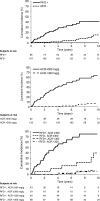Early renal function decline in type 2 diabetes
- PMID: 22076874
- PMCID: PMC3265342
- DOI: 10.2215/CJN.07610711
Early renal function decline in type 2 diabetes
Abstract
Background and objectives: Early decline in GFR may reflect progressive kidney disease in type 1 diabetes, but its predictive value in type 2 diabetes is uncertain.
Design, setting, participants, & measurements: In this longitudinal study, GFR was measured serially over approximately 4.0 years in 195 Pima Indians with type 2 diabetes. Renal function decline (RFD) was defined during this initial period by an average GFR loss ≥3.3%/yr, as defined previously in type 1 diabetes. Subsequently, participants were followed for up to 17.8 years to ESRD onset, death, or December 31, 2010, whichever came first.
Results: RFD prevalence during the initial period was 32% in 68 participants with normal baseline albuminuria (albumin/creatinine ratio [ACR] < 30 mg/g), 42% in 88 with microalbuminuria (ACR 30 to <300 mg/g), and 74% in 39 with macroalbuminuria (ACR ≥300 mg/g; P<0.001). The cumulative incidence of ESRD 10 years after the initial period was 41% in those with RFD and 15% in those without (P<0.001); 41 of the 49 ESRD cases (83.7%) occurred in participants who had or developed macroalbuminuria during the initial period. When adjusted for age, sex, diabetes duration, and hemoglobin A1c, the ESRD hazard rate was 4.78 times (95% confidence interval, 2.39-9.58) as high in those with RFD as in those without; further adjustment for albuminuria attenuated this association (hazard ratio, 1.79; 95% confidence interval, 0.82-3.91).
Conclusions: In type 2 diabetes, loss of GFR often occurs before the onset of macroalbuminuria, but a decline predictive of ESRD is strongly dependent on progression to macroalbuminuria.
Figures
References
-
- Perkins BA, Ficociello LH, Silva KH, Finkelstein DM, Warram JH, Krolewski AS: Regression of microalbuminuria in type 1 diabetes. N Engl J Med 348: 2285–2293, 2003 - PubMed
-
- Perkins BA, Ficociello LH, Ostrander BE, Silva KH, Weinberg J, Warram JH, Krolewski AS: Microalbuminuria and the risk for early progressive renal function decline in type 1 diabetes. J Am Soc Nephrol 18: 1353–1361, 2007 - PubMed
Publication types
MeSH terms
Grants and funding
LinkOut - more resources
Full Text Sources
Medical


